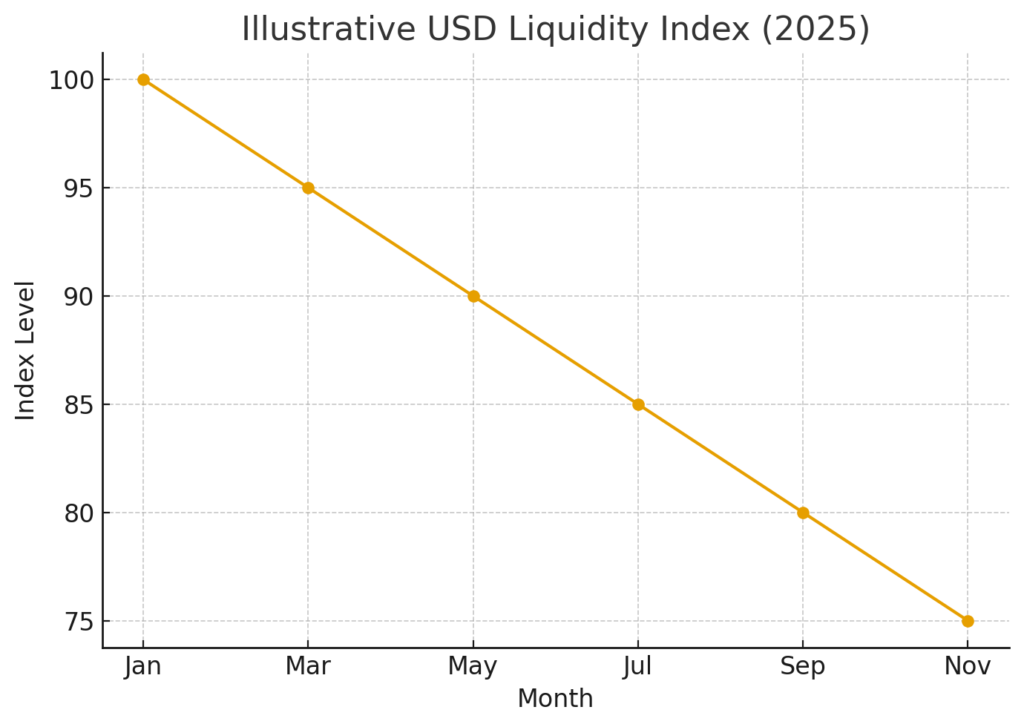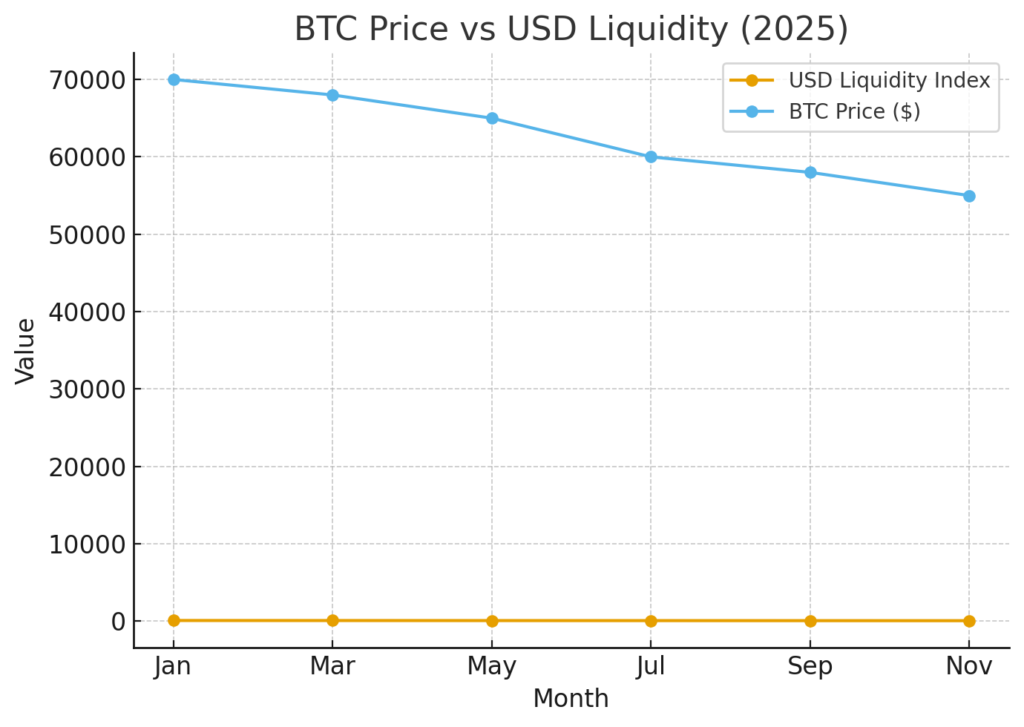
Main Points :
- Global USD liquidity is shrinking, tightening financial conditions and pushing investors away from risk assets such as Bitcoin.
- Bitcoin’s weakness is not caused by crypto-native events, but by macroeconomic pressure originating from U.S. monetary policy.
- A recovery in USD liquidity will be the key signal for renewed crypto inflows toward year-end.
- Crypto and traditional finance are now fully intertwined, meaning the crypto market cannot escape global liquidity cycles.
- Investors searching for new assets or yield opportunities must monitor macro indicators, not only crypto-specific developments.
I. The Cascading “Risk-Off” Chain Triggered by Falling USD Liquidity
Arthur Hayes—BitMEX co-founder and one of the most influential macro-crypto analysts—has again pointed to a familiar culprit behind Bitcoin’s recent downward trend: shrinking global USD liquidity.
His argument is simple but powerful:
Bitcoin is not falling because of problems in the crypto industry.
Bitcoin is falling because the world is running out of dollars.
Why Dollar Liquidity Matters
In global finance, the U.S. dollar acts as the settlement engine. When the Federal Reserve tightens policy—raising interest rates, reducing its balance sheet (QT), or draining liquidity through repo operations—the impact is immediate:
- Global banks reduce leverage
- Investors sell risk assets
- Capital flows back toward U.S. Treasuries
- Crypto markets lose speculative demand
This creates a risk-off cascade, where highly volatile assets such as Bitcoin become the first to be sold.
Macro Factors Behind the Liquidity Squeeze
Several key forces have contributed to the current tightening:
- Federal Reserve balance-sheet reduction (QT)
- High short-term interest rates, pulling capital into the U.S. money market
- Declining Treasury General Account (TGA) liquidity injection
- Decreased dollar supply in global offshore funding markets
Hayes stresses that these are not temporary distortions—these are fundamental liquidity drains affecting all risk assets equally.
Crypto Cannot Escape Macroeconomics
For years, Bitcoin was seen as an isolated ecosystem. But the maturation of the crypto market—ETF approvals, institutional liquidity, derivatives expansion—means crypto now behaves like a global macro asset.
Bitcoin’s declines in 2025 illustrate this vividly:
- When USD liquidity drops → BTC falls
- When liquidity rises → BTC rallies almost instantly
Crypto’s correlation to dollar liquidity has become stronger than its correlation to halving cycles, ETF inflows, or narrative-based catalysts.

II. Year-End Outlook: Liquidity Recovery as the Only “Buy Signal” That Matters
Hayes argues that Bitcoin will likely struggle to gain upward momentum toward year-end unless USD liquidity improves.
This goes against the common crypto belief that:
- ETF inflows
- Institutional adoption
- Geopolitical instability
- Bitcoin halving effects
…will push BTC upward regardless of macro conditions.
Hayes insists the opposite:
Without fresh dollar liquidity, every crypto rally will fade.
What Liquidity Recovery Looks Like
According to Hayes, the critical macro signals to watch are:
- Fed slowing or pausing QT
- Repo operations injecting net liquidity
- Lower short-term yields
- Expansion in bank reserves
- Rising TGA spending
When these indicators flip positive, investors may see renewed inflows into:
- Bitcoin
- High-beta altcoins
- Emerging L2 chains
- Infrastructure tokens
- Early-stage venture-grade crypto assets
For readers seeking “the next new asset” or “the next income source,” liquidity conditions matter more than any single project update.
Why Investors Should Not Be Distracted by Volatility
Hayes warns that short-term volatility—liquidations, ETF outflows, or exchange-specific news—are noise.
The real signal is central bank liquidity.
When USD liquidity expands, crypto markets typically enter multi-month bull runs.
When USD liquidity contracts, crypto enters stagnation or decline.
III. Crypto’s Integration Into Traditional Finance: A Double-Edged Sword
Hayes’ most important point is that crypto has now become an inseparable part of global financial markets.
This integration brings both strength and vulnerability.
Strength: Crypto Has Become a Legitimate Global Asset
- Institutional investors treat Bitcoin like a macro commodity
- BTC ETFs embed crypto directly into traditional portfolios
- Corporate treasuries hold crypto as alternative reserves
- Global banks offer custody, derivatives, and settlement solutions
This is exactly what crypto advocates wanted for years.
Vulnerability: Crypto Is Now Exposed to Global Liquidity Shocks
But the cost of legitimacy is exposure:
- When the bond market sells off → crypto sells off
- When USD funding tightens → crypto funding tightens
- When risk appetite collapses → crypto collapses first
Bitcoin, which once thrived on its independence, now reflects the same macro pressure as equities and commodities.
Crypto is no longer separate—it is fully financialized.

IV. What This Means for Investors Seeking New Crypto Assets or Yield
Hayes’ analysis provides practical guidance for investors searching for:
- New crypto opportunities
- Alternative revenue streams
- Tokens with real-world utility
- Early-stage protocols
- High-yield on-chain strategies
The message is clear:
Macro conditions determine the success of micro opportunities.
Even the strongest tokenomics, or the most innovative blockchain product, cannot overcome a macro liquidity drain.
To identify promising assets during a liquidity squeeze, investors should:
- Focus on tokens with real utility: payments, infrastructure, L1/L2 scaling, RWA settlement
- Avoid highly leveraged ecosystems vulnerable to liquidation cascades
- Monitor stablecoin supply as a proxy for crypto-native liquidity
- Watch U.S. Treasury yields (a leading indicator for risk appetite)
- Track stablecoin minting and exchange reserves
When liquidity returns, early-positioned investors will benefit first.
V. Conclusion: Liquidity Is the Master Variable
Arthur Hayes’ message is not bearish—it is realistic.
Bitcoin is not failing.
Crypto is not broken.
Investors are not fleeing because of fear.
The world simply does not have enough dollars.
When liquidity returns, Bitcoin will likely resume its structural uptrend, and altcoin markets will begin a new rotation cycle. But until that shift occurs, disciplined investors must watch the macro environment rather than the daily crypto headlines.
For those seeking new assets or yield opportunities, understanding liquidity dynamics is the single most powerful advantage in the current market.

